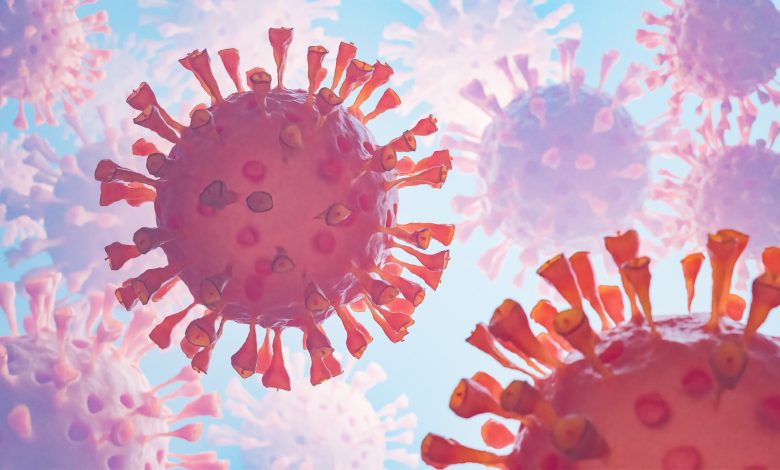
What Do We Know About Mutated Versions of Covid-19? UK strain the deadliest
ما نعرفه عن النسخ المتحورة من «كورونا»: «البريطانية» الأكثر فتكاً
Al-Sharq Al-Awsat online – WGOQatar Translations
Paris: The technical terms “mutations” and “strains” are very disturbing and sometimes a source of confusion. Here’s what we know about them in relation to the Covid-19 epidemic.
At this stage, three mutated strains are of concern according to the World Health Organization: the one discovered in England, the one discovered in South Africa, and the third in Japan (this strain was discovered by travelers from Brazil and from here it was called “the Brazilian mutant”), AFP reported.
These three mutants are found in 125, 75 and 41 countries, respectively, according to WHO. They are classified as “alarming” due to their increased transmissibility and – or severity – and thus exacerbate the pandemic and make it more difficult to control, as defined by WHO. The next category is the category of “interesting mutations”, which require monitoring because of their potentially problematic genetic characteristics.
Currently, WHO is monitoring three of them, first in Scotland, the United States and Brazil. There are many other variables that the scientific community seeks to define and evaluate.
“The coming weeks and months will tell us whether (these mutations) will be included in the category of concern that is spreading very quickly or if they will continue to spread at their current low rate,” Etienne Simon Laurier, head of the virus evolutionary genomics of RNA viruses unit at the Pasteur Institut (Paris), told AFP.
All of these mutants are classified according to family or “lineage.” According to the modifications it had acquired, they occupy a specific place in the main family tree of the “SARS-Cov-2” virus.
The emergence of mutated versions of the virus is not surprising. It is a natural process because the virus mutates over time to ensure its survival. The British health services published on its website: “More than 4000 SARS-CoV-2 mutants have been identified around the world.” But the WHO confirms that “most of them have no effect in terms of public health measures.”
It all depends on the mutations they carry. Thus, consequently, the British, South African and Brazilian strains carry a mutation called the N501Y, which is suspected to make them more transferable. The South African and Brazilian mutations also carry another mutation called E484K, which is suspected of reducing acquired immunity either through a previous infection (with an increased likelihood of reinfection) or by vaccines.
Due to the difficulty of tracking the mutants with technical names for non-specialists (for example, the British version is called “501 YV1” or “VOC 202012-01” and belongs to the “P1.7” strain), it has been named according to the country in which it appeared in. Therefore, the terms “British, South African, or Brazilian” are more understandable to people, but scholars do not like them as they see it as stigmatizing these countries.
There is consensus on this point regarding the three alarming mutated strains. But that only depends on the epidemiological data for now: Researchers are watching how quickly these mutants spread and conclude at which point they are most contagious. Therefore, a definitive figure cannot be obtained because results may differ based on the health restrictions in place in the areas where the mutants are common.
For example, based on various studies, WHO believes that the British strain of the Coronavirus is more contagious, with a rate ranging between 36% and 75%.
Several groups of researchers around the world are analyzing the biological properties of these mutations in an effort to find out why they are more contagious. “There are hypotheses that must be studied: The viral load may be higher or the mutant can enter cells more easily or it multiplies more quickly.” Said Olivier Schwartz, Director of the Virus and Immunity Unit at the Pasteur Institute.
Researchers at Harvard University put forward another hypothesis that infections caused by the British version can last longer: an infected person stays contagious longer than a person infected with the regular virus, which may require an extension of the quarantine period. But this type of research takes time, so researchers will need weeks or even months to get definitive answers.
This seems to be the case for the British strain. A study published on March 10 concluded that this mutation is 64% more deadly than the regular Coronavirus.
Out of a thousand cases that were discovered, the British mutant caused 4.1 deaths compared to 2.5 deaths caused by the regular Coronavirus, according to this study published in the medical journal “BMJ”, which confirms the first observations made by the British authorities at the end of January.
In addition, based on other studies conducted in South Africa, WHO estimates that the South African strain of coronavirus “increases the risk of death of hospitalized patients by 20%. According to many laboratory studies, the British strain has not significantly weakened the effectiveness of vaccines, but the Brazilian and South African mutations appear to have a significant impact on vaccines due to their E484K mutation.
However, the low effectiveness of vaccines against some mutations does not mean that they are no longer effective at all.
On the other hand, these studies focus on one response of the body after vaccination, which is the production of antibodies. “It does not evaluate other types of potential immunity, such as the activity of T and B lymphocytes,” said a recent article published in the specialized “JAMA” magazine by the American health expert, Anthony Fauci.
However, manufacturers are working on new versions of their vaccines specifically designed to combat mutations. Moderna announced on March 10th that it had begun offering a new generation of its vaccine to a group of patients as part of a clinical trial aimed at evaluating its effectiveness against the South African strain.
This adaptation is necessary because “mutations that may be less affected by current vaccines are likely to continue to emerge,” as the European Center for Disease Prevention and Control warned.
الشرق الأوسط أونلاين
باريس: يثير مصطلحا «الطفرات» و«المتحوّرات» التقنيان جداً القلقَ ويمثلان في بعض الأحيان مصدر إرباك. في الآتي أبرز ما نعرفه عنهما فيما يتعلق بوباء «كوفيد – 19».
في هذه المرحلة، تعد ثلاث نسخ متحورة مثيرة للقلق وفقاً لمنظمة الصحة العالمية: النسخة التي اكتُشفت في إنجلترا، وتلك المكتشَفة في جنوب أفريقيا، والثالثة في اليابان (اكتُشفت هذه النسخة لدى مسافرين قادمين من البرازيل ومن هنا سُميت «المتحوّرة البرازيلية»)، حسبما نقلت وكالة الصحافة الفرنسية.
هذه المتحورات الثلاث منتشرة في 125 و75 و41 بلداً على التوالي، وفقاً لمنظمة الصحة العالمية. وهي تُصنَّف «مثيرة للقلق» بسبب زيادة قابليتها للانتقال و-أو شدّتها، وبذلك تؤدي إلى تفاقم الجائحة وتجعل السيطرة عليها أكثر صعوبة، حسب تعريف المنظمة. والفئة التالية هي فئة «المتحورات المثيرة للاهتمام» وهي تتطلب مراقبة بسبب خصائصها الجينية التي قد تطرح إشكالية.
في الوقت الحالي، تراقب منظمة الصحة العالمية ثلاثاً منها رُصدت أولاً في اسكوتلندا والولايات المتحدة والبرازيل. وينتشر كثير من المتحوّرات الأخرى التي يسعى المجتمع العلمي إلى تحديدها وتقييمها.
وقال إتيان سيمون لوريير، رئيس وحدة الجينوم التطوري للفيروسات في معهد باستور (باريس) لوكالة الصحافة الفرنسية: «الأسابيع والأشهر المقبلة ستخبرنا ما إذا كانت (هذه المتحورات) ستُدرج ضمن الفئة المثيرة للقلق التي تنتشر بسرعة كبيرة أو إذا كانت ستستمر في الانتشار بوتيرتها الحالية المنخفضة».
وكل هذه المتحورات مصنَّفة وفقاً للعائلة أو «السلالة». وحسب التعديلات التي اكتسبتها، تحتل مكاناً محدداً في شجرة عائلة فيروس «سارس – كوف – 2» الرئيسي.
ظهور نسخ متحورة من الفيروس ليس أمراً مفاجئاً. فهو عملية طبيعية لأن الفيروس يتحوّر بمرور الوقت لضمان بقائه. وكتبت الخدمات الصحية البريطانية على موقعها على الإنترنت: «تم تحديد أكثر من 4000 متحورة من (سارس – كوف – 2) حول العالم». لكن منظمة الصحة العالمية تؤكد أن «معظمها ليس له تأثير لجهة تدابير الصحة العامة».
وكل ذلك يتوقف على الطفرات التي تحملها. وبالتالي، فإن كلاً من النسخة البريطانية والجنوب أفريقية والبرازيلية تحمل طفرة تسمى «إن 501 واي» يشتبه في أنها تجعلها أكثر قابلية على الانتقال. كذلك، تحمل النسختان الجنوب أفريقية والبرازيلية طفرة أخرى تسمى «إي 484 كيه» يُشتبه في أنها تخفّض المناعة المكتسَبة إما عن طريق عدوى سابقة (مع زيادة احتمال الإصابة مرة أخرى) أو عن طريق اللقاحات.
ونظراً لصعوبة تتبع المتحورات ذات الأسماء التقنية بالنسبة إلى غير المختصين (على سبيل المثال، النسخة البريطانية تسمى «501 واي في 1» أو «فوك 202012-01» وتنتمي إلى سلالة «بي 1.1.7»)، فقد أطلقت عليها تسميات حسب البلد الذي ظهرت فيه. لذلك فإن مصطلحات «المتحورة البريطانية أو الجنوب أفريقية أو البرازيلية» مفهومة أكثر للناس، لكن العلماء لا يحبذونها إذ يرون أنها تحمل وصمة لتلك البلدان.
هناك إجماع على هذه النقطة فيما يتعلق بالنسخ الثلاث المتحورة المثيرة للقلق. لكنّ ذلك يعتمد فقط على البيانات الوبائية في الوقت الحالي: يراقب الباحثون مدى سرعة انتشار هذه المتحورات ويستنتجون عند أي نقطة تكون أكثر عدوى.
لذلك، لا يمكن الحصول على رقم قاطع لأن النتائج قد تختلف استناداً إلى القيود الصحية المعمول بها في المناطق التي تنتشر فيها المتحورات.
وعلى سبيل المثال، استناداً إلى دراسات مختلفة، ترى منظمة الصحة العالمية أن النسخة البريطانية من فيروس «كورونا» أكثر عدوى بنسبة تتراوح بين 36 و75%.
وتقوم مجموعات عدة من الباحثين حول العالم بتحليل الخصائص البيولوجية لهذه المتحورات سعياً لمعرفة سبب كونها أكثر عدوى. وقال أوليفييه شفارتز، رئيس وحدة الفيروسات والمناعة في معهد «باستور»، إن «هناك فرضيات تجب دراستها: قد يكون الحمل الفيروسي أعلى أو أن المتحوّرة يمكنها أن تدخل الخلايا بسهولة أكبر أو أنه يتكاثر بسرعة أكبر».
وطرح باحثون في جامعة هارفارد الأميركية فرضية أخرى مفادها أن العدوى التي تسببها النسخة البريطانية يمكن أن تستمر لفترة أطول: يبقى الشخص المصاب مُعدياً لفترة أطول من المصاب بالفيروس العادي ما قد يتطلب تمديد فترة الحجر. لكنّ هذا النوع من البحث يستغرق وقتاً، وبالتالي سيحتاج الباحثون إلى أسابيع أو حتى إلى أشهر للحصول على إجابات قاطعة.
يبدو أن هذه هي الحال بالنسبة إلى المتحوّرة البريطانية. فقد خلصت دراسة نُشرت في 10 مارس (آذار) إلى أن هذه النسخة أكثر فتكاً بنسبة 64% من فيروس «كورونا» العادي.
من بين ألف حالة تم اكتشافها، تسببت المتحورة البريطانية في حدوث 4,1 وفيات مقابل 2,5 وفاة تسبب بها فيروس «كورونا» العادي، وفقاً لهذه الدراسة المنشورة في المجلة الطبية «بي إم جي» والتي تؤكد الملاحظات الأولى التي قدمتها السلطات البريطانية في نهاية يناير (كانون الثاني).
وبالإضافة إلى ذلك، واستناداً إلى دراسات أخرى أُجريت في جنوب أفريقيا، تقدّر منظمة الصحة العالمية أن النسخة الجنوب أفريقية من فيروس «كورونا»، «تزيد من خطر وفاة المرضى القابعين في المستشفى بنسبة 20%». وفقاً لكثير من الدراسات المخبرية، لم تتسبب المتحورة البريطانية كثيراً في إضعاف فاعلية اللقاحات لكن يبدو أن النسختين البرازيلية والجنوب أفريقية لهما كبير أثر على اللقاحات بسبب طفرة «إي 484 كيه» التي تحملانها.
لكنّ ضعف فاعلية اللقاحات ضد بعض المتحوّرات لا يعني أنها لم تعد فعالة على الإطلاق.
من جهة أخرى، تركز هذه الدراسات على استجابة واحدة للجسم بعد التلقيح وهي إنتاج أجسام مضادة. وجاء في مقال نشرته أخيراً مجلة «جاما» المتخصصة للخبير الصحي الأميركي أنتوني فاوتشي: «إنها لا تقيّم أنواعاً أخرى من المناعة المحتملة مثل نشاط الخلايا اللمفاوية التائية والبائية».
وفي كل الأحوال، يعمل المصنِّعون على إصدارات جديدة من لقاحاتهم مصمَّمة خصيصاً لمقاومة المتحوّرات. وأعلنت شركة (موديرنا) في 10 مارس أنها بدأت تقديم جيل جديد من لقاحها لمجموعة من المرضى كجزء من تجربة سريرية تهدف إلى تقييم فاعليته ضد المتحوّرة الجنوب أفريقية.
وهذا التكيف ضروري لأن «المتحوّرات التي قد تكون أقل تأثراً باللقاحات الحالية (…) من المحتمل أن تستمر في الظهور» كما حذر المركز الأوروبي للوقاية من الأمراض ومكافحتها.
المصدر: aawsat



